General advice warning:
The information and any advice provided in this booklet has been preparedwithouttaking into account your objectives, financialsituation or needs. Because ofthat, you should, before acting on the advice, considerthe appropriateness ofthe advice, having regard to those things.
Retirement Toolkit
Retirement in Australia is evolving. With Australians living longer than ever, today’s retirees face a dynamic mix of opportunities and challenges. They need financial security amid rising living costs, access to quality health care, a safe and comfortable home, and ways to stay socially connected and purposeful. This tool kit is designed to help Australian retirees(and those nearing retirement) navigate these key areas, providing guidance and practical tips to enhance their retirement years. From managing money matters to embracing a fulfilling lifestyle, each section of the toolkit addresses a core need – helping you transition into or enrich your retirement with confidence and peace of mind.
Financial Planning & Security
Retirement financial planning is about ensuring peace of mind that your money will last as long as you do. This means understanding your income sources(like superannuation, investments, or the Age Pension) and matching them to your living costs. In Australia, many retirees still rely on the Age Pension – in fact, nearly half of retired Australians count the government pension as their main income source. At the same time, costs for a “comfortable” retirement are rising with inflation, so careful budgeting and asset management are vital. The good news is there are many tools and supports available to help you make the most of what you have and enjoy a comfortable standard of living in retirement.
To frame your planning, it helps to know some benchmarks. The Association of Superannuation Funds of Australia (ASFA) provides a Retirement Standard for a modest versus comfortable lifestyle. For example, as of 2024, a single homeowner needs roughly $52,000 per year for a comfortable retirement, whereas a couple needs about $73,000.Amore frugal, “modest” life style might require around $33,000 (single) or $48,000 (couple) annually. By comparison, the full Age Pension pays about $30,000 per year for singles and $45,000 for a couple –meaning retirees who want comfort of ten must draw on superannuation or savings to supplement the pension.
Financial Planning & Security
The table below summarizes these figures:
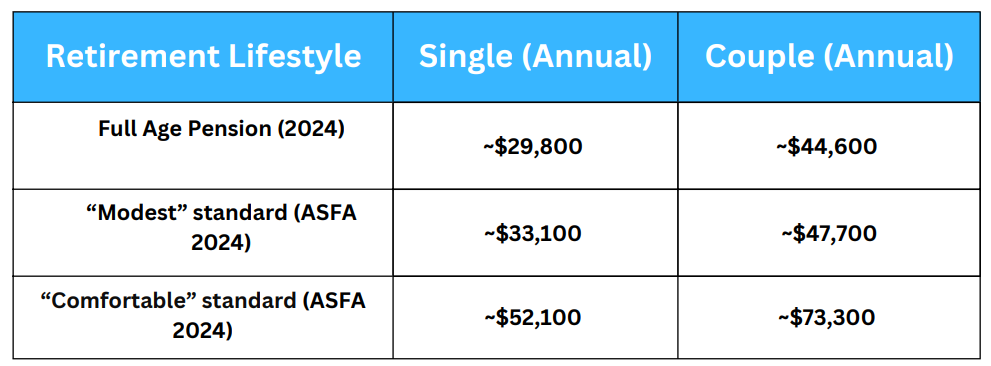
(All figures assume retirees own their home outright.)
Understanding these benchmarks can help you evaluate your own situation. If there’s a gap between your expected expenses and your expected income, don’t panic – there are steps you can take (and government supports to tap into) to close it. The key is to have a plan rather than “winging it,” because retirees who plan financially tend to feel more confident and happier in retirement. Below, we outline some key steps and top tips for financial security
Key Steps
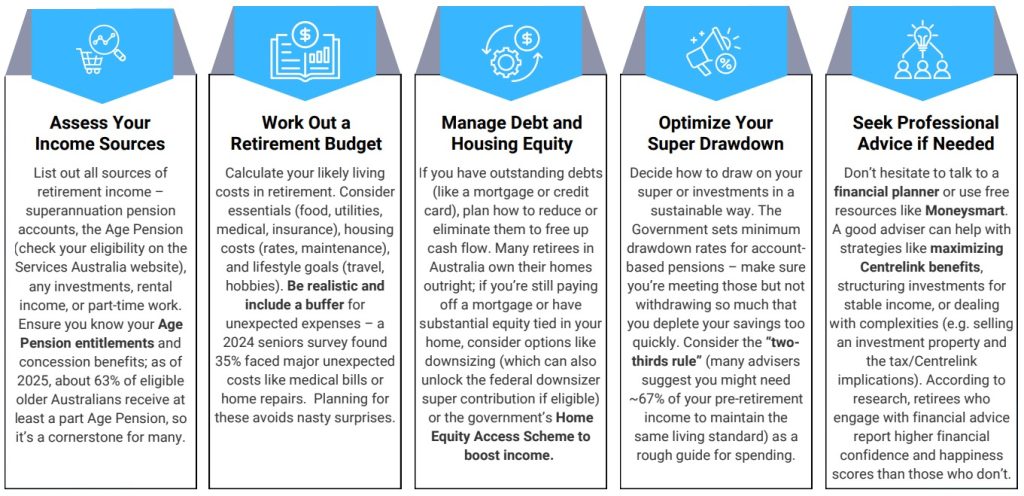
Top 5 Tips
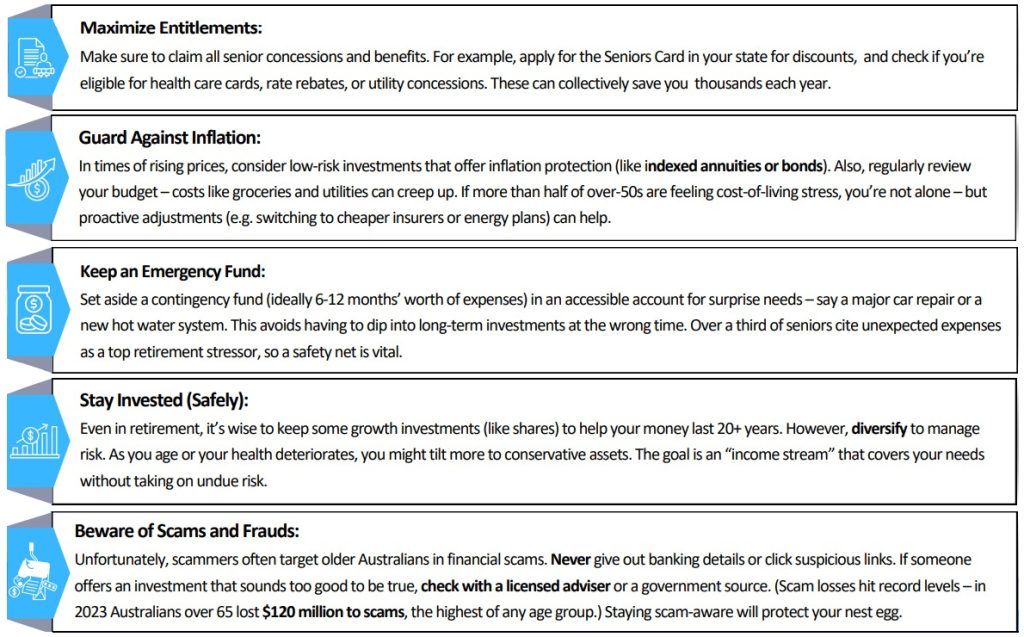
Health & Well Being
Good health is the bedrock of a happy retirement. As the saying goes, “health is wealth” – staying as healthy as possible will let you enjoy your golden years to the fullest. Australia is fortunate to have one of the highest life expectancies in the world, with the average 65-year old man expected to live into his mid-80s and women into their late 80s. However, living longer also means managing chronic conditions and maintaining fitness. Most older Australians(around 80% of those 65+) have at least one chronic health issue (like arthritis, heart disease, or diabetes), and over a quarter have multiple conditions. The goal isn’t to be perfect – it’s to manage these health challenges proactively so you can stay independent and feel your best.
Maintaining well-being is multi-faceted: it includes physical health (regular exercise, nutrition, medical care),mental health (staying positive and mentally active), and preventive care (screenings and immunisations). The Australian government supports seniors’ health through Medicare (with free or subsidized GP visits, specialist care, and preventive programs) and the Pharmaceutical Benefits Scheme (PBS) which makes many medicines affordable. There are also free annual preventive programs – for example, flu shots for over-65s, bowel cancer screening kits mailed out at ages 50-74, etc. By taking advantage of these and adopting a healthy life style, retirees can significantly improve their quality of life. Below are key steps to manage health and some practical tips to sustain your well-being
Key Steps
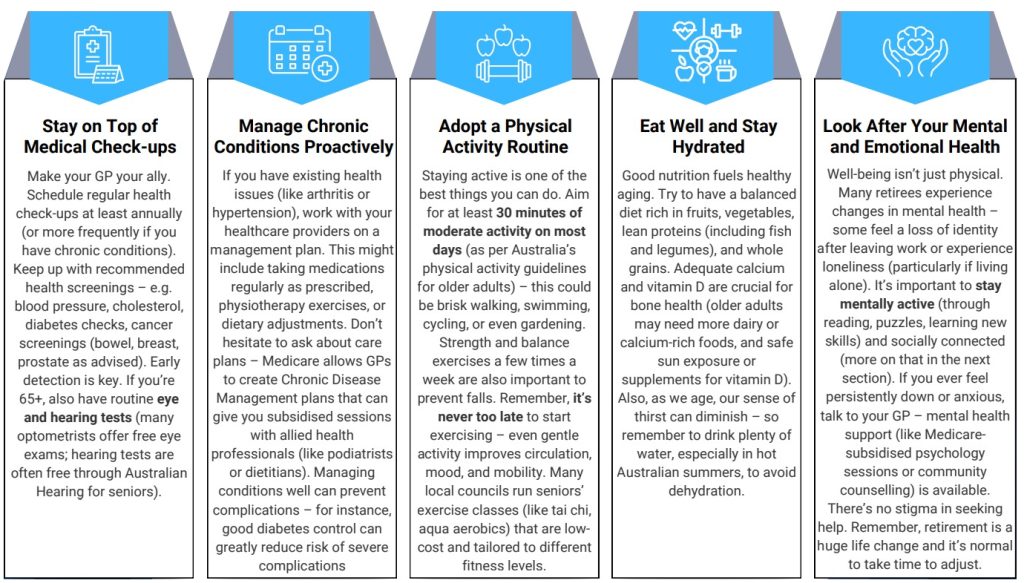
Top 5 Tips
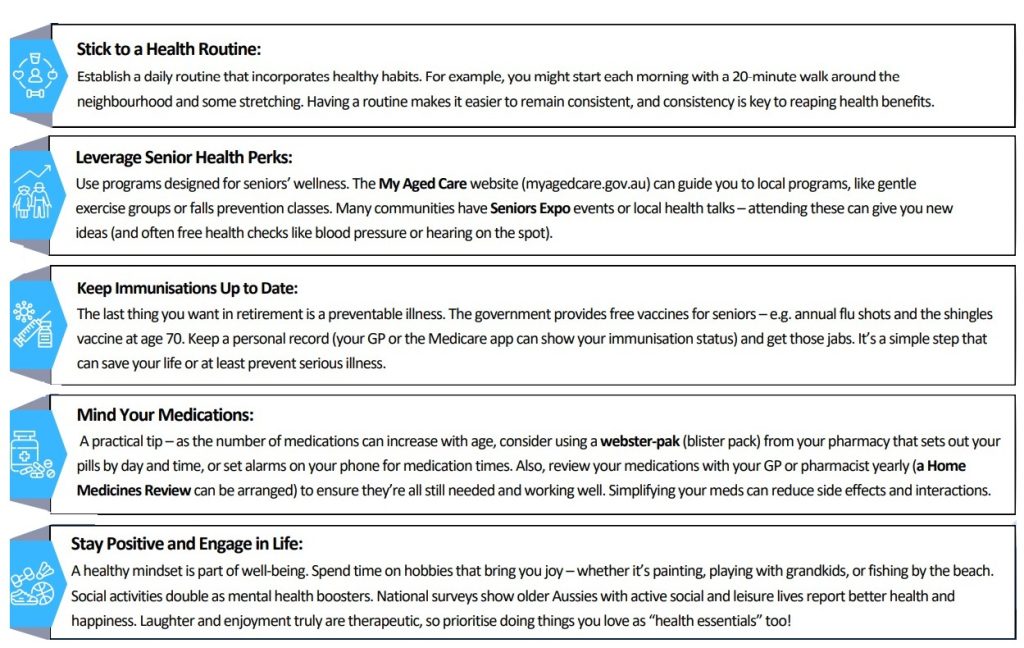
Health & Well Being
By prioritising your health, you are investing in your independence and happiness. Small daily choices – from taking a walk instead of sitting, to choosing a salad more often – add up over the years. And Australia’s health system is there to support you: Medicare, public hospitals, and community health services forma safety net, while private health insurance (if you have it) can offer additional options. Remember that 80% of older Australians have at least one chronic condition – so if you’re managing health issues, you’re certainly not alone, and help is available. With a proactive approach, you can maximize not only your lifespan but your “health span” – the years of life that you spend in good health, doing what you enjoy.
Housing & Living Arrangements
Your home in retirement should be your sanctuary – a place that’s comfortable, safe, and suits your needs as you age. Housing is a major consideration: do you stay in the long-time family home, downsize to something smaller or more accessible, or perhaps move into a retirement village or seniors’ apartment? There’s no one-size-fits-all answer – it depends on personal preference, health, family, and finances. The vast majority of older Australians today live in private homes in the community (over 95% of people 65+ live in households, not in aged care), and survey after survey shows most people wish to age in place at home if possible. In fact, about 80% of older Australians want to remain in their current home as they age, and about 62% would prefer to get any needed care services at home rather than move into a facility. These strong preferences highlight why it’s so important to plan your living arrangements to support aging in place.
However, staying in the large family home isn’t always practical or economical. Some retirees find the upkeep (cleaning yards, maintaining a pool, etc.) becomes burdensome or costly. Others find that their home, while sentimentally valuable, may not be physically suitable long-term(think of multi-story houses with stairs, or homes with big gardens requiring constant work).On the flipside, leaving a home full of memories can be emotionally hard, and downsizing or moving involves costs (stamp duty, agent fees) and potential impact on Age Pension means tests. The decision needs careful thought, ideally well before an urgent health issue forces it. Here are key steps to consider regarding housing, and some tips whether you stay or move.
Key Steps
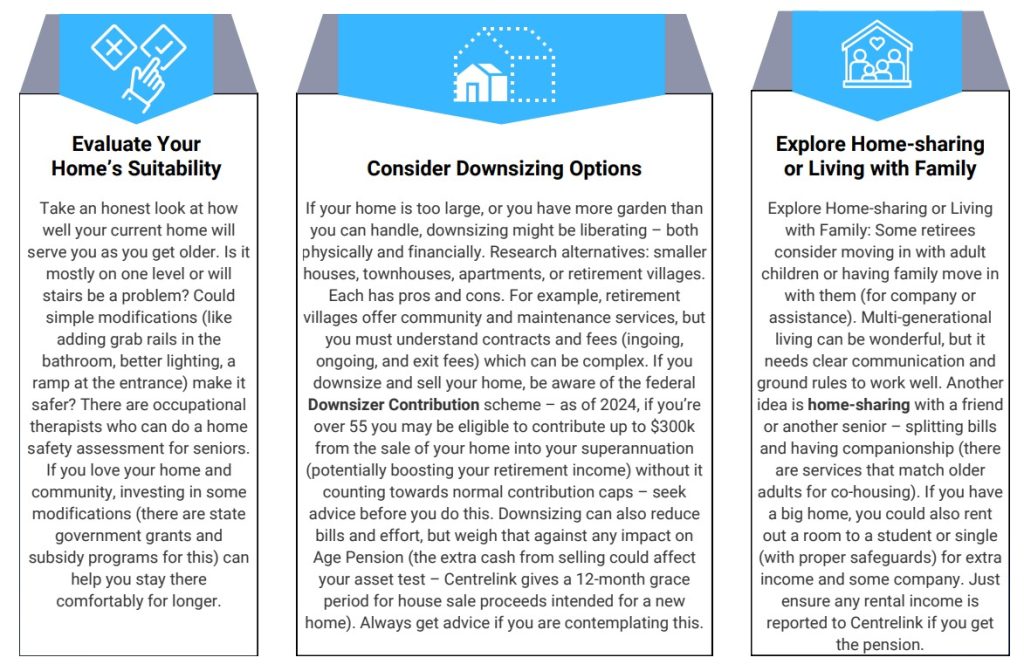
Key Steps
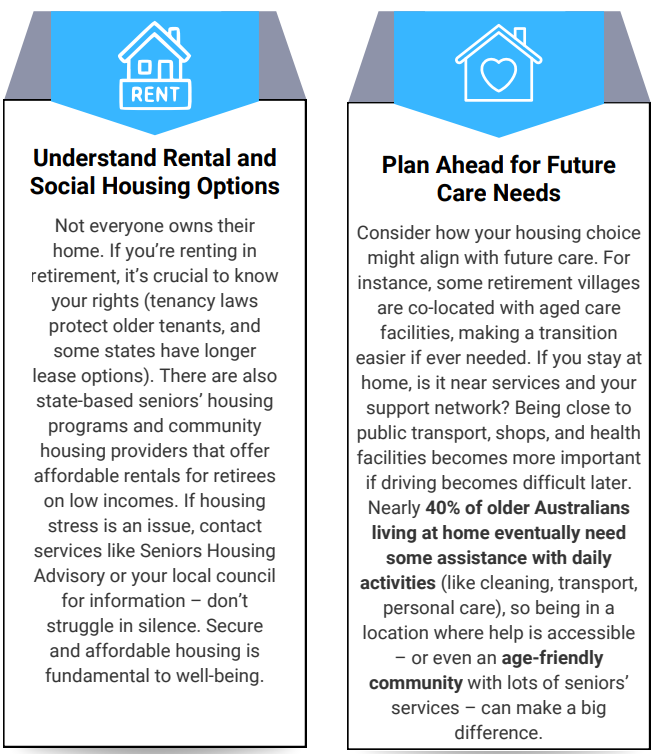
Top 5 Tips
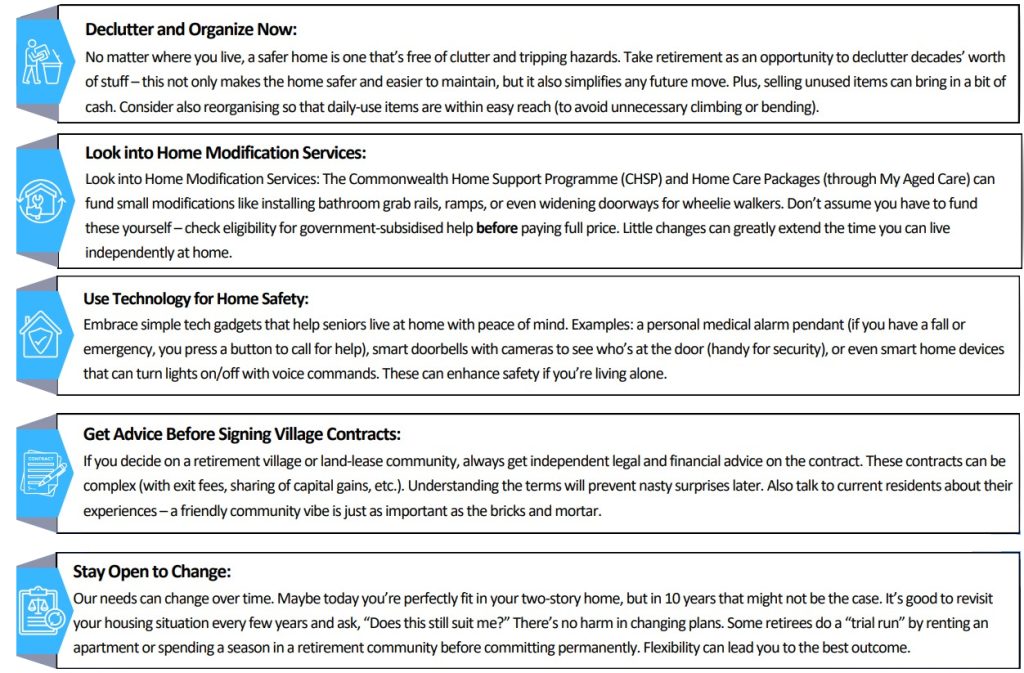
Housing & Living Arrangements
Remember, the goal is comfort, safety, and happiness in your living environment. Whether that’s the long-time family home filled with grandkids’ laughter, a chic downsized condo near the city, or a peaceful retirement village by the coast – it should be a place that makes you feel at home. Take the time to make the right housing choice for you, and don’t be afraid to seek out advice (from financial counsellors, senior housing services, or other retirees who’ve been through it). A well-considered living arrangement will support all the other aspects of a fulfilling retirement.
Administrative & legal Essentials
Retirement is the perfect time to get your affairs in order so that you and your family have peace of mind. Legal and administrative planning might not be fun, but it’s critically important. This includes making or updating your Will, setting up an Enduring Power of Attorney (EPOA) and Enduring Guardianship/Advance Care Directive (for medical and personal decisions), and organizing important documents. Think of it as a gift to your loved ones – clear instructions and legal documents will save them stress and uncertainty later. Unfortunately, a large portion of Australians have not sorted these basics: more than half of Australians die without a valid Will, according to legal experts. Even among those over 50, one-third don’t have a Will yet. So, if you’re in that boat, you’re certainly not alone – but it’s never too late to take action on this front.
Key legal documents every retiree should consider include:

By handling these matters, you lighten the load on your family and ensure your legacy is handled as you intend. Here are some action steps and tips to guide you:
Key Steps
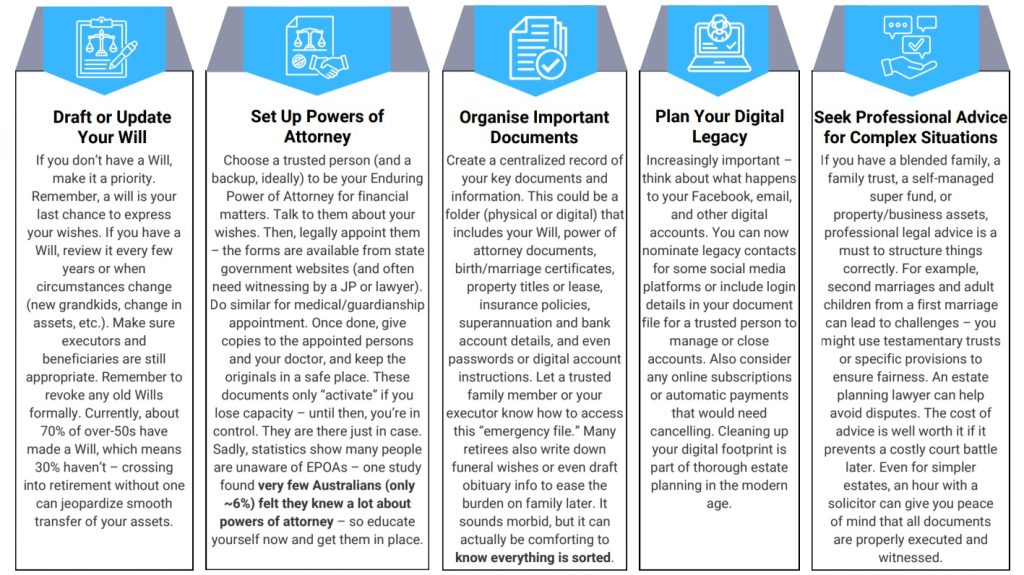
Top 5 Tips
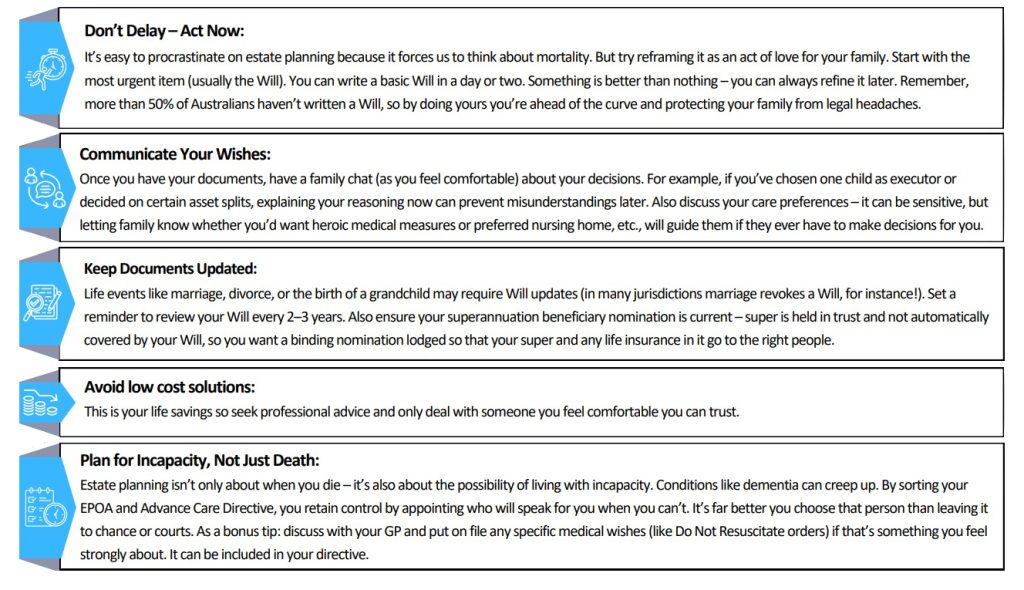
Once these legal pieces are in place, you can breathe a sigh of relief. It’s a one-time effort that yields long-term security. Keep your documents in a safe (fire-proof if possible) or with your solicitor and let your executors/attorneys know how to access them. Then get on with enjoying life, knowing that if fate throws a curveball, you’ve done your best to make things easier for yourself and your loved ones.












